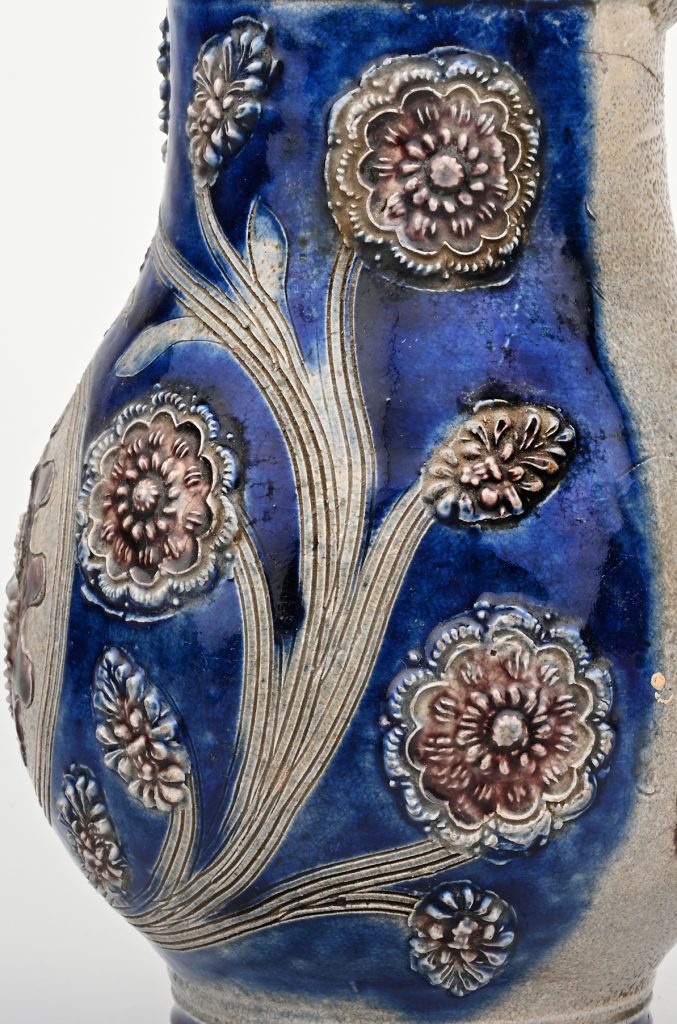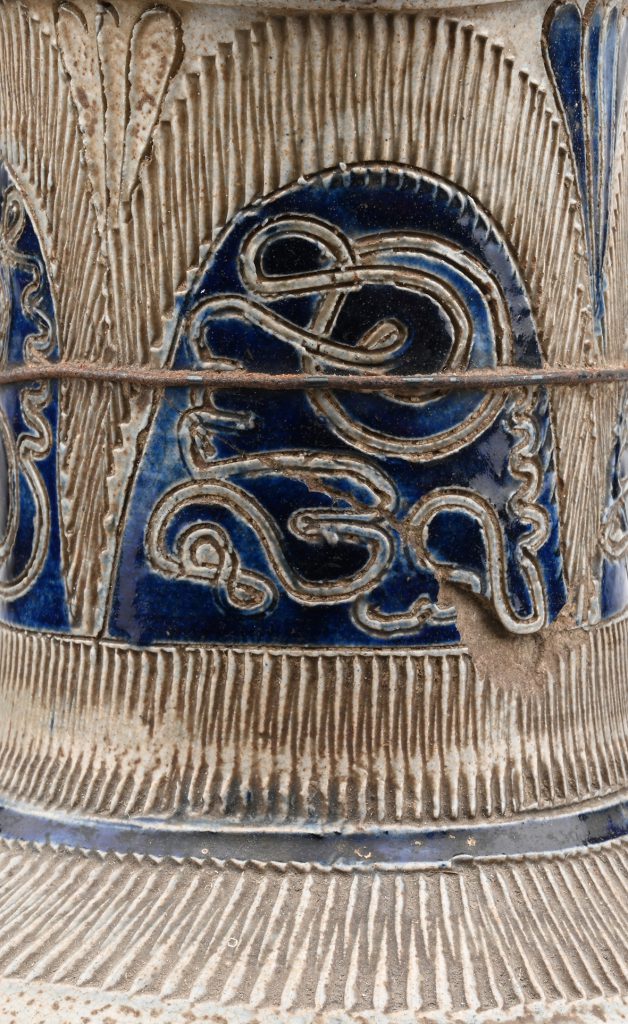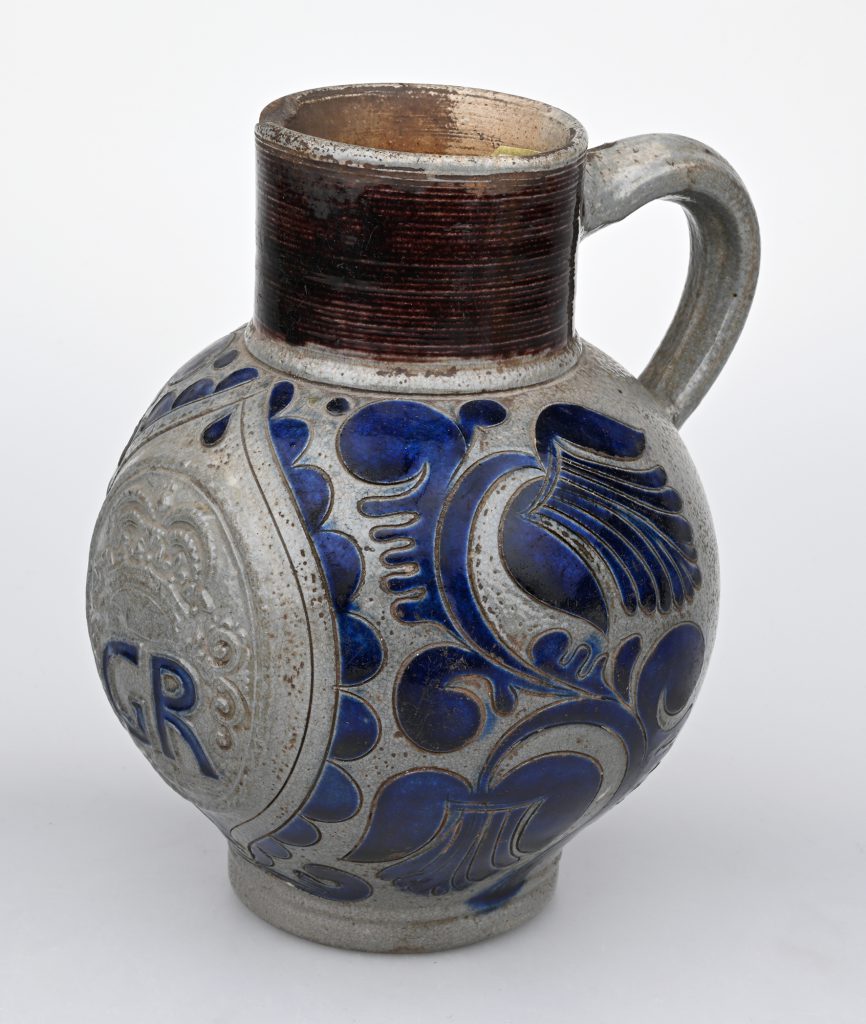
Andreas Heege 2019
This decoration is a variant of incised decoration. It was a technique specifically associated with “Westerwald” stoneware and involved incising linear grooves, tendrils and pedicels onto the surfaces mainly of jugs with rounded bodies, early pear-shaped jugs and tankards using a multi-pronged implement (fork). The bundles of linear grooves usually end in an applied decoration in relief in the shape of a flower, petal or leaf. The vessels were also often tinted blue using cobalt smalt or painted with manganese purple.
Gabeldekor decorations and pear-shaped jugs were some of the ceramic novelties of the late 17th century and were also found among the assemblage recovered from the Waisenhausplatz site in Bern (Heege 2009, Fig. 39, see also List 4 containing further examples from Bern). The technique was only used for a relatively short period of time between c. 1675 and 1710/15. It is worth noting that the pattern was not represented among the “Westerwald” stoneware finds from Altenrath near Cologne, which dated from the period prior to c. 1680/1690 (Francke 1999, 96; Büttner 1997, 57 and 76).
A series of ceramic vessels with applied decorations in relief support the date proposed above: Koetschau 1924, Pl. 71, dated by applied moulded relief to 1680; Falke 1908, Vol. 2, 112 Fig. 258, dated to 1685; Reinhold 1990, 42, dated to 1687; Solon 1892, 107 Fig. 183 and Pl. XXV as well as 114 Fig. 190, dated to 1687 and 1691; Seewaldt 1990, Cat. nos 371, 392a, dated to 1689 and 1691; Strauss/Aichele 1992, Cat. no. 85, dated to 1710, 86, dated to 1687; Hume 2001, 105 Fig. V.14, dated to 1700; Gaimster 1997, Cat. nos 120, 122, 123, dated to 1679, 1680, 1683, 1687, 1687 and 1691; Skerry/Hood 2009, 41-51, dated prior to 1702, prior to 1714; Keramikmuseum Westerwald Inv. A 3401, dated to 1676; D 5644, dated to 1693; St 0303, dated prior to 1702; Reineking von Bock 1986, Cat. Nos 531, 533, 538, 539, dated to 1680, 1687, 1693, 1699.


“Westerwald” stoneware, decorated with incised lines (late decoration made with a forklike tool) and rocker-stamped decoration.
In the later stages of the pattern’s use (early 18th century), the number of parallel incised lines was reduced to two, which made it easier to achieve looser, intertwined lines (Skerry/Hood 2009, 49, dated by an applied decoration to 1724).
An assemblage from a cesspit at the Areal Glocke site in Winterthur is a particularly accurate representation of the pottery dating from the period around 1700. As well as earthenware with inscribed dates from between 1678 and 1700, the assemblage includes a Westerwald stoneware tankard with an applied decoration dating it to 1697, incised decorations made with a forklike tool and applied rosettes, tankards and jugs painted in cobalt blue and manganese purple, a jug with a rounded body decorated with vertical applied strips, tankards with friezes of diamond-shaped bosses and a jug with a rounded body decorated with Gabeldekor. Pear-shaped jugs, however, are not yet included (Frascoli 1997, Pl. 42, 58 and 60).

Jug with a rounded body, Gabeldekor and an octagonal applied decoration bearing the dates of 1688 and 1694 (Bernisches Historisches Museum H2299).
The Bernisches Historisches Museum’s collection includes a particularly splendid example of this type of decoration; it also bears an octagonal Imperial Eagle, the signature G.R. and the date 1688. The vessel itself is a jug with a rounded body bearing a small applied decoration in the shape of a two-handled pot with an inscribed cherub, dated 1694. As shown by the associated date, “G.R.” in this case does not mean Georgus Rex (George I was not King of England until 1714) but must refer to the unknown Westerwald potter or mould cutter involved in the making of the vessel. The same applies to the initials “W.R.” associated with other applied moulded decorations.

Jug with a rounded body bearing an applied moulded decoration with the initials “GR” (Georgus Rex), incised lines made with a two-pronged tool around the medallion and a simple incised decoration consisting of a single line on the rest of the jug, c. 1720/1730.
The Gabeldekor technique evolved into the characteristic incised decoration (known as Reddekor in the Westerwald region) of the late 17th and, more typically, of the 18th and 19th centuries, where simple incised lines separated the blue-tinted areas from the grey ones, thus preventing the colour from bleeding.
Translation Sandy Haemmerle
German: Gabeldekor
French: décor à la fourchette
References:
Büttner 1997
Andreas Büttner, Steinzeug Westerwälder Art des ausgehenden 16. Jh. bis 1800 in Lüneburg (Archäologie und Bauforschung in Lüneburg Band 3), Lüneburg 1997.
Falke 1908
Otto von Falke, Das rheinische Steinzeug, Osnabrück 1908.
Francke 1999
Ursula Francke, Kannenbäcker in Altenrath. Frühneuzeitliche Steinzeugproduktion in Troisdorf-Altenrath, Siegburg 1999.
Frascoli 1997
Lotti Frascoli, Handwerker- und Kaufmannshaushalte im frühneuzeitlichen Winterthur. Untersuchungen zu vier Liegenschaften in der Altstadt (Monographien der Kantonsarchäologie Zürich 29), Zürich/Egg 1997.
Gaimster 1997
David R. M. Gaimster, German Stoneware 1200-1900. Archaeology and cultural history, London 1997.
Heege 2009
Andreas Heege, Steinzeug in der Schweiz (14.–20. Jh.). Ein Überblick über die Funde im Kanton Bern und den Stand der Forschung zu deutschem, französischem und englischem Steinzeug in der Schweiz, Bern 2009.
Hume 2001
Ivor Noël Hume, If these pots could talk. Collecting 2000 years of British household pottery, Milwaukee, WI 2001.
Koetschau 1924
Karl Koetschau, Rheinisches Steinzeug, München 1924.
Reineking-von Bock 1986
Gisela Reineking-von Bock, Steinzeug (Kataloge des Kunstgewerbemuseums Köln 4), Köln 1986.
Reinhold 1990
Harald Reinhold, Zur Geschichte des Keramikmuseums Westerwald, in: Keramikmuseum Westerwald. Deutsche Sammlung für historische und zeitgenössische Keramik Höhr-Grenzhausen (Museum), Braunschweig 1990, 18-67.
Seewaldt 1990
Peter Seewaldt, Rheinisches Steinzeug. Bestandskatalog des Rheinischen Landesmuseums Trier, Trier 1990.
Skerry/Findlen Hood 2009
Janine E. Skerry/Suzanne Findlen Hood, Salt-Glazed stoneware in early America, Williamsburg 2009.
Solon 1892
Marc Louis Emmanuel Solon, The Ancient Art Stoneware of the Low Countries and Germany or ‘Grès de Flandres’ and ‘Steinzeug’ : Its Principal Varieties and the Places Where it Was Manufactured During the XVIth and XVIIth Centuries, London 1892.
Strauss/Aichele 1992
Konrad Strauss/Frieder Aichele, Steinzeug (Battenberg Antiquitäten-Kataloge), Augsburg 1992.

